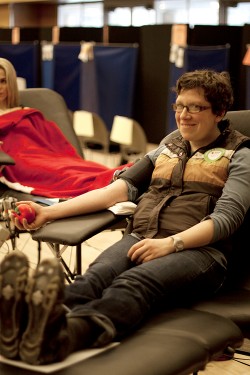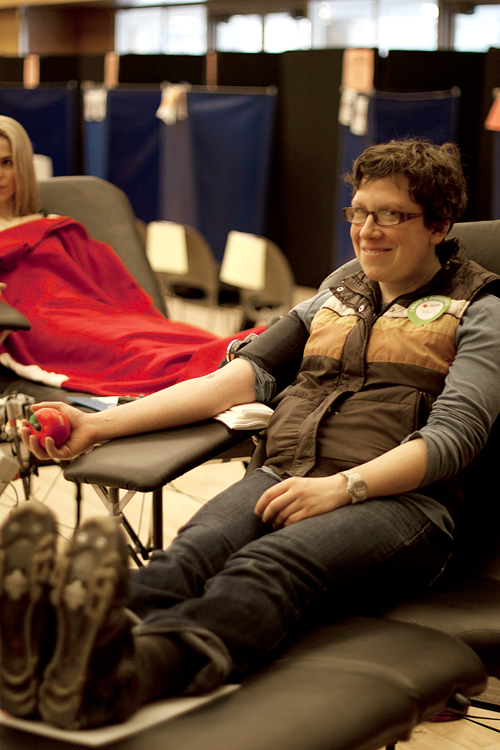Last week, Portland State, in collaboration with the Red Cross, held its first week-long blood drive. Organizers aimed to collect 741 units of blood from all blood types (a unit of blood is roughly one pint). Housed in the third-floor ballroom of Smith Memorial Student Union, the week-long event saw a steady stream of donors. By the end of the drive, the initial goal of 741 units had been far surpassed and organizers projected a final donation total of 813 units—nearly 110 percent of the goal.
PSU community saves lives, one pint at a time
Last week, Portland State, in collaboration with the Red Cross, held its first week-long blood drive. Organizers aimed to collect 741 units of blood from all blood types (a unit of blood is roughly one pint). Housed in the third-floor ballroom of Smith Memorial Student Union, the week-long event saw a steady stream of donors. By the end of the drive, the initial goal of 741 units had been far surpassed and organizers projected a final donation total of 813 units—nearly 110 percent of the goal.

Some students, like senior psychology major Rebecca Sylvia, had donated before, and others, like junior biology major Benjamin Thomas, had never donated blood. Both Sylvia and Thomas left their respective donation experiences feeling satisfied and knowing they had done a good deed.
“It was relatively easy. People always need blood; it is a good thing to do,” Sylvia said.
Thomas, who sat down for the longer, double red-cell donation, echoed Sylvia’s sentiments: “I figured it was a good time to start. It was easy. There was a small amount of anxiety, but it was not so bad. The needle did not hurt much—it felt strange, and was over in less than a second,” he said.
Organized by Gwyn Ashcom, health educator at the Center for Student Health and Counseling, and Red Cross Donor Recruitment Representative Nate Saunders, the winter 2012 blood drive not only saw a high turnout, but also broke a PSU record. Monday, Jan. 30 was the most successful blood donation day in PSU history, with 176 total units of blood collected. Tuesday’s tally was just one shy at 175 total units donated. By the end of Thursday, more than 689 units of blood had been collected.
“We are projecting that 2,439 lives will be affected by this drive,” Saunders said, “It is phenomenal.”
Demand for blood is high; the Red Cross needs almost 5,000 units of blood per week to keep up, and the success of local blood drives is imperative to meeting that demand. Typically, the Red Cross has a blood supply that would last one to three days on its own; however, the supply can fluctuate, which is why community donations are so important. Additionally, during the summer months the stock of blood is hardest hit, as 20 percent of blood donations come from school drives. The summer of 2011 saw the worst shortage of blood in 12 years.
Donating blood is “a free way to give back to people in need,” Saunders said. “One blood donation has the potential to impact three lives. Recipients can be trauma victims or cancer patients. For them the blood product is a matter of life and death.”
The history of blood drives at PSU goes back to the 1950s and the Korean War, when PSU was still known as the Vanport Extension Center. It wasn’t until the 1980s that blood drives became a regular part of the academic year’s schedule. Thanks to the efforts of Franzi Herman, former nurse in Health Services, blood drives became a once-per-term event, with a general goal of collecting 200 pints of blood from donors.
About eight years ago, Ashcom took over the responsibilities of coordinating blood drives. Since then, there has been a continuous growth in the length of blood drives, as one day became two days, three days became four days, until now, when the blood drive lasted an entire week. According to Ashcom, the blood drives have been successful: “We have yet to reach a plateau; we always manage to top it. The drives keep growing—it is great to see.”
Portland State is the second largest donation site in the Portland Metro area next to the Red Cross Portland Donor Center. Since 2009, PSU donors have given more than 3,000 units of blood.
“We have got a great population of regular donors,” Ashcom said. “The staff makes PSU their place to donate. For students, it is right on campus and convenient.”
According to the Red Cross website, there are multiple types of blood donations, but blood drives such as this one focus on two specific types: whole blood donation, which is the most common type of blood donation; and double red-cell donation, which focuses specifically on the red blood cells. For whole blood donations, the process generally takes about an hour, and for double red-cell donations, the process takes approximately an hour and a half. In that period, donors spend time registering with a vast portion spent monitoring vitals and hemoglobin. The actual donation, however, generally only lasts five to 15 minutes (or longer for double red-cell donations).
According to Saunders, the procedure is relatively pain-free. Once the needle is placed in the vein, the pain recedes as there are no nerves in a vein. In fact, there are more nerves on the fingertips than in the arms, so the actual blood drawing process is not as uncomfortable as the initial sample taken to determine if a donor is capable of giving blood. “For a few moments of discomfort, you can save a life,” Saunders said.
All in all, PSU’s first week-long blood drive was a resounding success. There was an incident of vandalism connected to the ineligibility of homosexual male donors, but the Federal Drug Administration prohibits donations from homosexual men and the Red Cross is required to follow FDA’s guidelines.
Saunders gives his gratitude to the PSU community. “Thank you for your support. This is saving lives. We would not be able to do it without you. We would also love to see some student organizations at PSU help get the word out. Donating is great for volunteer hours.”
For information on where to find a location to donate, visit redcrossblood.org. Student organizations that wish to coordinate additional community blood drives can do so through collaboration with the Red Cross. And those who cannot give blood can help in other ways by volunteering to help organize or man the stands at blood drives.
The next blood drive at PSU will be another week-long event, held from Monday, April 16 to Friday, April 20.






